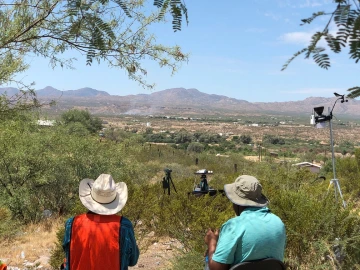
STOP BURNING PROJECT
Researchers and community engagement staff from the Southwest Environmental Health Sciences Center (SWEHSC) at the University of Arizona teamed up with staff from a local tribal Environmental Protection Agency to study the effects of trash burning and to develop a data-driven education campaign to reduce trash burning within their community.
In 2014, The Tribe identified an ongoing, open trash-burning issue within their community. According to tribal EPO staff, open burning has been outlawed since 2015 due to concerns about chemical exposure from the burns. Unfortunately, there aren’t enough resources to enforce this law.
The vastness of the community is too much for Game and Fish rangers to monitor and the EPA staff are not authorized to give out citations. Monitoring for open burning also grows to be more difficult during the night time, which is said to have the most activity. We know that the health effects of open burning include: nausea, fatigue, dizziness, burning eyes, headaches, and asthma exacerbation. More chronic effects include organ damage, emphysema, and some cancers.
The team developed a three-part plan to direct the project:
1) Conduct exposure assessment to sample air pollutants,
2) Survey the knowledge, practices, and attitudes of local tribal members concerning trash burning,
3) and generate community-directed education information to be shared at outreach events.
The project is led by tribal EPA staff, with the support of Dr. Marti Lindsey and other SWEHSC Staff. Dr. Mary Kay O’Rourke and her team from the SWEHSC are leading the exposure assessment. The survey data is being administered and collected by the SWEHSC Community Engagement Core staff with support from local tribal college students. An overarching goal for this project is to increase the level of Environmental Health Literacy within the tribal community. The project is essentially responsible for helping community members make healthier choices for their solid waste disposal. This responsibility also includes providing science education on environmental health and creating information that can lead to overall systemic change.
